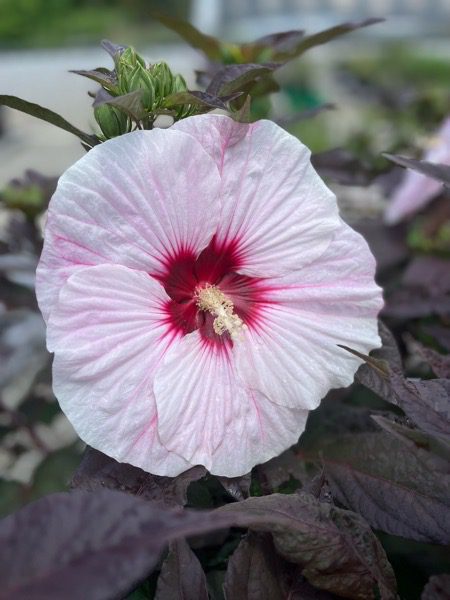Hibiscus, Perfect Storm
Price range: $14.99 through $89.99
Plant, Zone 4+
Discount per quantity
| Quantity | 3 - 8 | 9 - 14 | 15+ |
|---|---|---|---|
| Price | Price range: $14.54 through $87.29 | Price range: $14.09 through $84.59 | Price range: $13.49 through $80.99 |
| % Discount | 3% | 6% | 10% |
Description
Hibiscus ‘Perfect Storm’: A Bold Beauty for Every Garden
Hibiscus ‘Perfect Storm’ lives up to its name. This plant blends powerful color, striking foliage, and nonstop summer blooms into one stunning package. It is a hardy hibiscus, so it can handle cold winters and still return year after year. But what makes it so special is the contrast — dark, almost black leaves paired with giant white blooms splashed with pink.
In this article, we explore everything you need to know about Hibiscus ‘Perfect Storm.’ From its growth habits and care tips to design ideas and seasonal changes, this guide will help you fall in love with this remarkable plant.
A Storm of Color and Texture
Perfect Storm is a showstopper. Its flowers are huge, often reaching eight to ten inches across. The petals are crisp white, edged in soft pink, and centered with a bold red eye that radiates outward. This color combination looks hand-painted and stands out even from a distance.
The foliage is equally dramatic. Deep burgundy leaves create a striking backdrop for the blooms, making each flower pop. Even before the plant flowers, the dark leaves add depth and interest to garden beds.
Growth Habit and Size
Perfect Storm forms a compact, rounded mound. It usually grows about three feet tall and spreads to around four feet wide. This tidy shape makes it ideal for smaller gardens, mixed borders, or even large containers.
In spring, the plant emerges slowly, often later than other perennials. But once warm weather arrives, growth is fast and vigorous. By midsummer, the plant is covered in buds, and flowering begins in earnest.
Choosing the Right Spot
Sunlight is key to success with Perfect Storm. Full sun ensures the best flower production and darkest foliage color. At least six hours of direct sun each day is ideal.
The soil should be rich, moist, and well-drained. Hardy hibiscus love water but do not tolerate standing water around their roots. If you have heavy clay soil, mix in compost or plant in raised beds to improve drainage.
Good air circulation also helps keep the foliage healthy and reduces the chance of fungal issues during humid summers.
Planting Steps for Success
- Plant at the right time – Late spring to early summer works best, once the soil is warm.
- Prepare the soil – Add compost or organic matter to enrich the planting site.
- Dig a wide hole – The hole should be twice as wide as the root ball but no deeper.
- Set the plant in place – Position the root ball so the crown is level with the ground surface.
- Backfill and water – Fill in with soil, press gently, and water thoroughly to settle.
- Mulch generously – Apply mulch around the base to conserve moisture and keep weeds down.
Watering and Feeding
Perfect Storm thrives on consistent moisture. During active growth and flowering, water deeply two to three times per week. Avoid letting the soil dry out completely. Drought stress can lead to fewer flowers and dropped buds.
Fertilize in spring as new shoots emerge. A balanced fertilizer or one slightly higher in potassium encourages strong blooms. Feed every four to six weeks through midsummer, then stop in late summer to allow the plant to prepare for dormancy.
Pruning and Seasonal Care
Pruning hardy hibiscus is simple. In late fall or early spring, cut back old stems to about six inches above the ground. New growth will emerge from the base once temperatures warm up.
Deadheading (removing spent blooms) is not required, but it can improve appearance. Since flowers only last a day or two, new buds keep the display fresh without extra effort.
Winter Hardiness
Perfect Storm is cold-hardy in USDA zones 4–9. After frost, the plant dies back to the ground. Apply a thick layer of mulch to insulate the roots during winter, especially in colder zones.
Do not worry if it seems late to sprout in spring. Hardy hibiscus are often among the last perennials to wake up. Give it time, and it will reward you with vigorous growth and massive blooms.
Perfect Storm vs. Spinderella
Both Perfect Storm and Spinderella are hardy hibiscus with large, showy flowers. The key differences are in foliage and color tone. Perfect Storm has deep burgundy leaves, while Spinderella has green leaves. Perfect Storm’s flowers are white with a pink edge and a red center, while Spinderella’s blooms are creamy white with more pronounced pink swirls.
If you prefer darker foliage and a bolder, more dramatic look, Perfect Storm is your match. If you want a softer, whimsical vibe, Spinderella might suit you better. Many gardeners grow both for variety and extended color impact.
Companion Plant Ideas
Perfect Storm works beautifully in mixed plantings. Pair it with plants that complement its bold flowers and dark leaves:
- Silver or gray foliage – Plants like lamb’s ear or Russian sage create striking contrast.
- Tall ornamental grasses – Their fine texture balances the hibiscus’s large leaves.
- Late-blooming perennials – Coneflowers, black-eyed Susans, and daylilies keep the show going.
- Bright annuals – Calibrachoa, petunias, or coleus add seasonal color at the base.
Pollinator Magnet
The large, open blooms are irresistible to bees, butterflies, and hummingbirds. The red center acts as a nectar guide, drawing pollinators straight to the flower’s heart. Planting Perfect Storm supports your local pollinator population while adding beauty to your garden.
Container Growing
Perfect Storm’s compact size makes it excellent for large containers. Choose a pot at least 18 inches wide and deep. Use high-quality potting mix with good drainage. Container plants dry out faster, so water often during hot summer days.
Feed regularly through the growing season to maintain healthy blooms. In colder zones, move containers to a sheltered spot or insulate them during winter.
Pests and Problems
Hardy hibiscus are resilient, but a few issues can appear:
- Japanese beetles may chew leaves and flowers. Handpick or use traps nearby.
- Aphids can cluster on new growth. A blast of water or insecticidal soap controls them.
- Leaf spot or mildew may occur in humid conditions. Provide spacing and good airflow to prevent this.
Most problems are minor and rarely threaten the plant’s health.
Propagation
Propagation can be done by division or cuttings. In spring, dig up a mature clump and divide the roots into sections, replanting them right away. For cuttings, take softwood pieces in early summer and root them in moist soil or water. This is a great way to create more plants for free or share with friends.
Seasonal Highlights
- Spring – Slow emergence, deep burgundy foliage begins to show.
- Summer – Peak bloom season with huge white and pink flowers.
- Fall – Foliage holds color until frost, providing late-season interest.
- Winter – Dormant phase; roots rest beneath the soil, ready for next year.
Why Gardeners Choose Perfect Storm
This variety is beloved for its intense color contrast and compact form. It fits beautifully into small gardens but makes an impact in larger spaces, too. The dramatic flowers combined with dark foliage create a high-end look without requiring complicated care.
Gardeners also appreciate its reliability. Once established, Perfect Storm returns each year with even more vigor. Its long bloom season provides steady color during the hottest months of summer, when many perennials have faded.
Perfect for Modern and Cottage Gardens Alike
Perfect Storm adapts to different garden styles. In cottage gardens, it mixes with colorful perennials for a relaxed, natural vibe. In modern landscapes, it works as a bold focal point against clean lines and neutral backgrounds. Its dark foliage pairs well with stone, wood, and metal elements, making it versatile for many design themes.
A Plant That Feels Like Summer
There is something about Perfect Storm that captures the feeling of midsummer. The giant blooms, the vibrant contrast, the steady hum of pollinators — it all creates an atmosphere of energy and warmth. Even when viewed from indoors, the flowers draw your eye and lift your mood.
The Magic After the Storm
Hibiscus ‘Perfect Storm’ is more than a plant; it is an experience. Each bloom feels like a small celebration, unfolding fresh every morning. The dark foliage and bold flowers offer beauty that lasts all season, while its hardy nature ensures it comes back year after year.
If you are looking for a perennial that feels both dramatic and dependable, Perfect Storm may be exactly what your garden needs. Plant it once, care for it well, and watch as it turns ordinary summer days into something unforgettable.
Additional information
| Weight | N/A |
|---|---|
| Options | 4 in. (16.9 fl. oz.) Pot, 1 Gallon Pot, 3 Gallon Pot |





